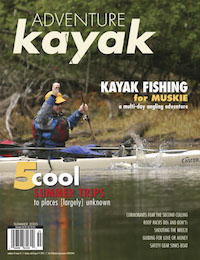When clients on a guided sea kayaking trip turn greener than the seaweed below, it’s not always from seasickness, more often it’s from envy.
Envy for a guide’s job is warranted when it’s summer in Johnstone Strait and the sun is shining, warming paddlers as they laze around on cobble beaches or dodge orcas surfacing in glassy waters under the gaze of snow capped peaks.
News flash Mr. corporate executive, Ms. school teacher with a pension plan: it’s not always fun in the sun. Replace that idyllic scene with four days of rain, with wind so strong boats
are beached, when there isn’t so much as a sparrow in sight and clients who have paid thousands of dollars to be sea kayaking are instead cloistered in their tents. At times like these I’d happily trade my job for the prospect of 20 years spent sitting behind an accountant’s desk, having my fresh water come from a cooler at the end of the hall.
Summers spent guiding disappear in a haze of trip after trip on the water. Snoozing in an often damp sleeping bag for 100 or more nights a year is a job requirement. Relationships starve as loved ones seek comfort elsewhere, leaving you with no enduring company except for the foot fungus nestled between your toes. You invariably miss weddings and parties. The novelty of the campfire burns out as quickly as dry cedar, leaving the smell of smoke to linger longer than it’s welcome in matted salty hair.
When it’s six in the morning on the fifth straight day of drizzle, most guides would happily trade glowing campfire embers for a timer on the coffee pot.
Then there are the guests. As a guide you get paid to do what others want to do. It’s about their experience, not yours. That means paddling at a starfish pace or missing that beautiful beach when the weak- er guests won’t make it through the surf break. Guests come in all manner of abilities, and dispositions, and there’s nothing a guide can do but deal with it—happily.
But.
Guides wake from the deepest self-pitying stupor with the first flinch clients make toward their back pockets. There may be no more clarifying moment in a guide’s job than the moment when he gets tipped by the client. There’s nothing like a few crisp bills in hand to make the guide realize the guests are usually great people after all and that guides get paid to do things others spend thousands of dollars to do.
Guides breathe salt air instead of taxi exhaust. They wake up to the sound of the ocean lapping at their tent door instead of the sound of sirens racing by. In the evenings they watch sunsets, not television crime dramas. During the day whales, seals, starfish and dolphins entertain them while city slickers have to make do with pigeons pooping
on statues and dogs barking from behind fences.
When the sun and whales cooperate and the clients are great or when the northern lights dance, phosphorescence swims in the waves and the conversation around the fire is easy, 10 dollars an hour (plus tip) seems like almost enough.




